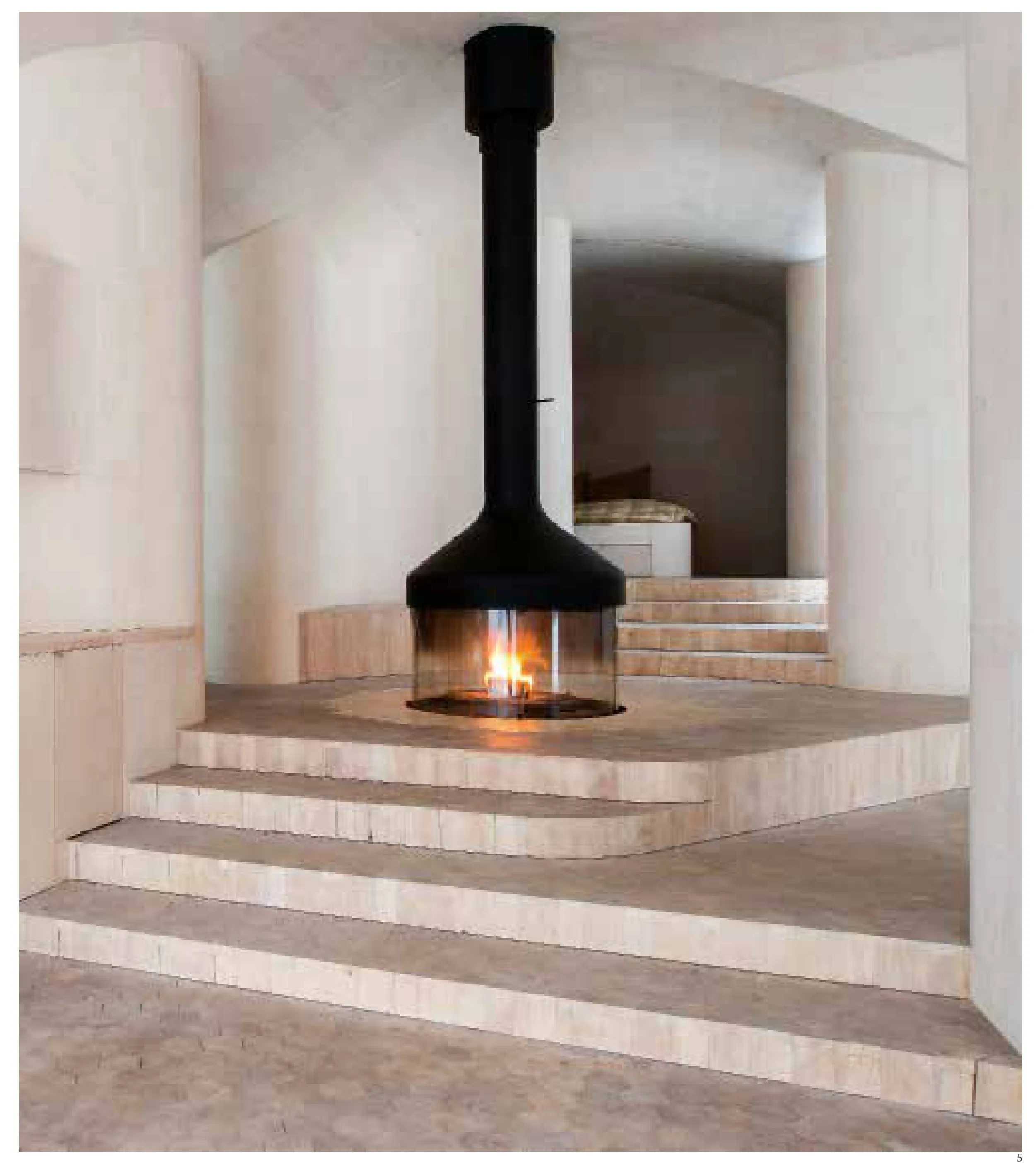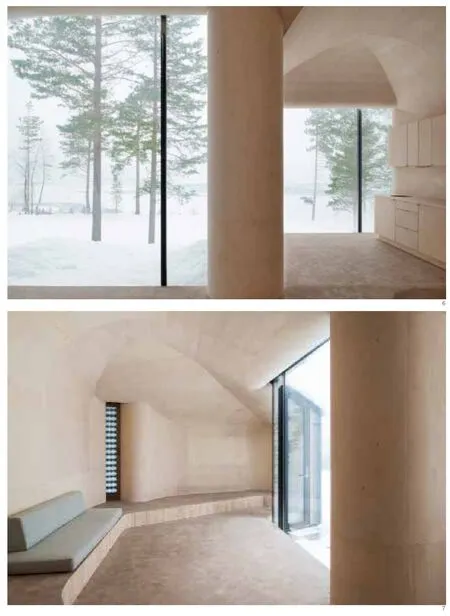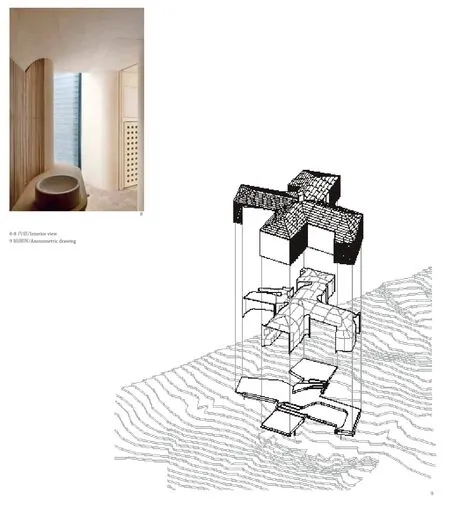诺德霍芬小屋,灵厄里克,布斯克吕郡,挪威
2014-03-27建筑设计奥斯陆工作室
建筑设计:奥斯陆工作室
诺德霍芬小屋,灵厄里克,布斯克吕郡,挪威
建筑设计:奥斯陆工作室
项目位于赫讷福斯镇郊外的克罗斯库根森林中,小屋坐落在一个陡峭的斜坡之上,四下眺望,斯泰因斯兰湖的美景尽收眼底。
场地四周皆无遮挡,完全曝露在风中。于是,小屋的设计从造型出发,创建出几个室外空间,用以在一天的不同时段为住户提供防风和荫蔽之所。建筑内部是一个由4mm桦木胶合板弯曲塑形而成的连续空间。曲面的墙体和天花连成一体,其几何结构定义出不同的功能区域。建筑平面依地势被分成4个主要层面,这些功能区域也因地板的高低不同而被自然划分。各层中间的过渡区域被设计成不同的台阶,为住户提供一些可坐可躺的地方。
火炉位于小屋的中心位置。火炉架挂在天花板上,生火区则在底部,位于入口层。这一设计营造出一种仿佛在营火旁的感觉,从屋内不同的地方都可以看到。
大面积的玻璃幕墙位于起居和就餐区域,幕墙的边框经过仔细的设计被巧妙地隐藏起来,令其无法从室内被看到。这为室内空间和外面的大自然建立了一个直接的联系。
从外观看,小屋有着较为规整的几何外形,墙壁和屋面都覆盖以20mm的石板,采用挪威西部传统的铺设式样。建筑结构采用层压板材,基础支撑材料是科图构造胶合板。科图板材是数控铣制的,建筑的内外都由其塑形而成。小屋由钻入岩石中的钢管作支撑,钢管外覆一圈小小的混凝土基础,用以稳定其结构。
屋子的大部分组成构件都是预制的,由娴熟的技术工人像拼拼图般将一个庞大而复杂的小屋拼装而成。□(王冰 译)
The project is located in Krokskogen forests, outside the town of Hønefoss. Its location on a steep slope gives a fantastic view over the Steinsforden.
The site is very exposed to the wind and the cabin is shaped to create several outdoor spaces that provide shelter from the wind and sun at diferent times of day. The interior is a continuous space fnished in curved 4mm birch plywood. The curved walls and ceilings form continuous surfaces, while the geometry defnes the diferent functional zones. ese zones are also created by the foor that follows the terrain and divides the plan into four main levels. The transition between levels creates diferent steps, places for sitting and lying down.
The freplace is located at the center of the cabin. The fireplace mantel hangs from the ceiling, while the fire is down at the floor of the access level. This provides the feeling of a campfire in the landscape that can be seen from diferent places.
Large glass walls are located in the living and dining areas and the framing is carefully detailed to avoid seeing it from the inside. is creates a direct relationship with the nature outside.
Outside, the cottage has a more rectangular geometry and the walls and roofs are covered with 20mm stone slabs laid in the traditional Western Norway pattern. The structure is done with laminated wood completed with a substructure of Kerto construction plywood. The Kerto is CNC milled and defnes the geometry both externally and internally.The cabin is supported by steel rods drilled into the rock with a smaller ring concrete foundation through the middle portion that stabilizes them.
The lodge consists mainly of prefabricated elements and is assembled as a large and complex puzzle by skilled craftsmen.□
项目信息/Credits and Data
项目团队/Project Team: Nils Ole Bae Brandtzæg, Thomas Liu, Marius Mowe, jonas Norsted, juan Ruiz, Bosheng Gan, Sveinn orarinsson
建筑面积/Floor Area: 70m2
委托类型/Comnission Type: 直接委托/Direct assignment, 2010
摄影/Photos: jonas Adolfsen (Fig.2, 5, 6, 7, 8), Atelier Oslo (Fig.3)
1 平面/Plan
2. 3 外景/Exterior view
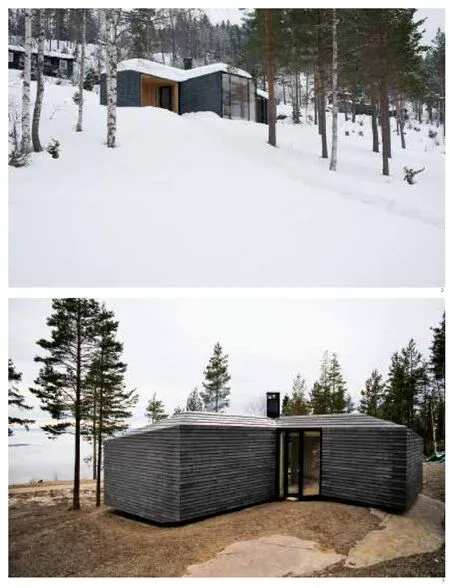
评论
胡恒:一个“学术性”的小宅子——早期赖特与晚期赖特的综合。前者是草原住宅的十字风车型平面,且以壁炉为空间旋转的枢纽。后者是室内无直线的“人体工程学”。只是,建筑师的求全,让两方面都略有缺憾。其一,火炉的中心位置,使空间的运动感有余,却凝聚力不足,丧失火炉的真正功能。即使形式、质感出众,但台阶的分层消解了其中心价值,难以形成汇聚的场所。如果它的位置偏向起居室与餐厅这边,可能会更好一些。其二,室内的全曲线应该包括家具、壁柜等……另外,设计者过于考虑每个房间的景观,室外光线采集过多,削弱了内部空间的北欧式“洞穴感”。在极端的外部环境下(暴雪之类),如果建筑还能留有少许幽暗的小空间,让灯具施展魅力,创造出温暖感与向心力,那么,它会更有味道。总的来说,设计者在手法上的雕琢,使建筑过分精美,有如按谱演奏,但也欠缺了一些大度和力量,而这正是其环境的本质。
赵仲贵:冰冷|温暖,秩序|无序,线性|曲面,一个空间|多个房间:这是一个充满对立特征的小屋。由于室内在空间和材料方面与外墙的处理迥然不同,显得有些“装修”化。壁橱和衣柜布置在了线性外表皮和自由曲面内胆间的夹层。室内没有设计门和隔断,房间之间仅做适当遮挡,墙壁和顶棚表面连续,地面随坡地而建, 给人以“穴居”的感受,房间中心的“营火”也强化了这一点。但太过流动的处理,让壁炉周围难以形成房子的核心空间。
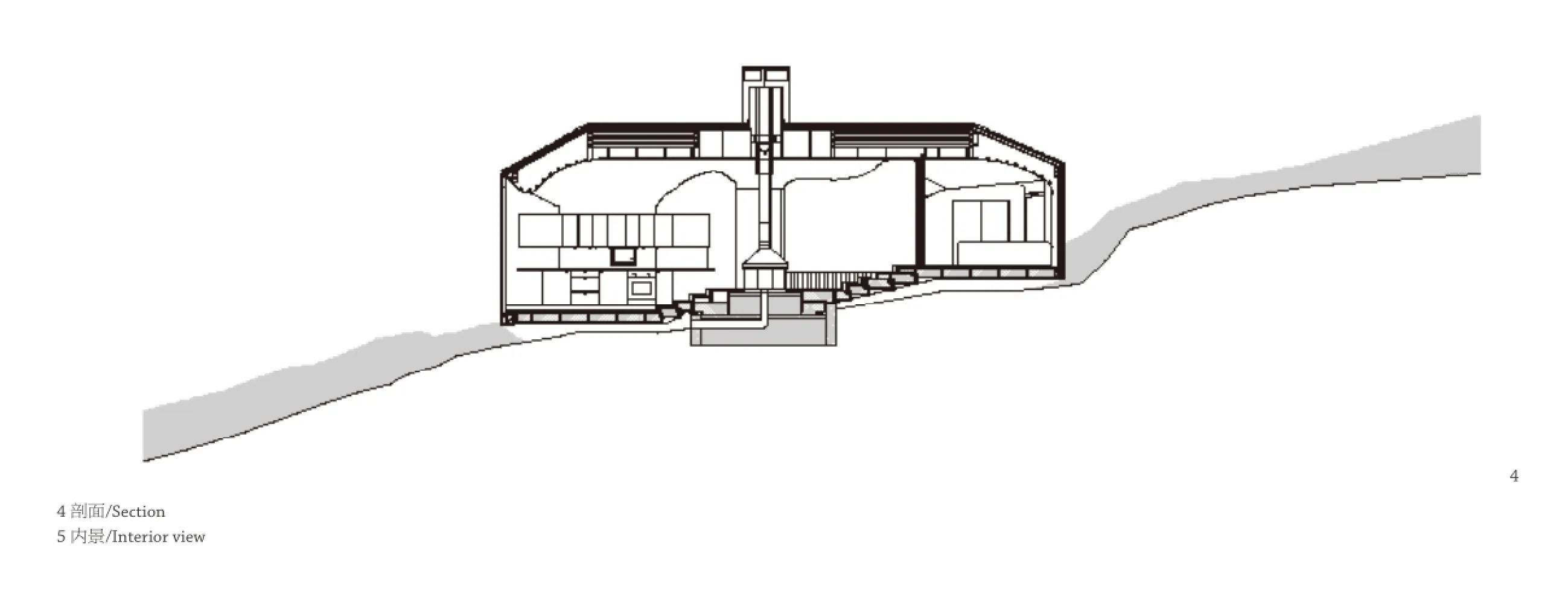
Comments
HU Heng: is is an "academic" cabin – a synthesis of Frank Lloyd Wright's early and late styles. It implies a prairie-style house with its cross-windmill foor plan, and it places a central freplace at the junction of the spatial rotation. The cabin references Wright's later styles by utilizing "ergonomics" to arrange the rooms without resorting to straight lines. But there are slight defects in the architect's pursuit of perfection. First, placing the fireplace in the center of the cabin amplifies the motion of the space but reduces the spatial cohesion. As a result, the real function of the fireplace is lost. Even though it is formally and materially exceptional, the steps surrounding the fireplace highlight the level differences of the room,disrupting its centrality and making it difficult as a gathering place. Furthermore, the curves of the spaces that defne the interior should also apply to furniture, cabinets and other fxtures. Additionally, because the designer was so focused on the exterior views from each room, outdoor lighting relating to these spaces has weakened the Nordic-style "cave feeling" of the cabin. During extreme weather, the building would have been more intriguing if the designer left a few small dark spaces in the house, spaces in which the light from lamps might help create a warm, charming and central force. Overall, the building is carved too delicately and its gestures lack generosity and strength. It misses the essence of its wooded environment.
ZHAO Zhonggui: is is a dwelling full of contrasts: cold and warm; order and license; rectilinear and curvilinear; a singular space and multiple zones. The interior space seems aesthetically determined in light of the completely different treatments of interior and exterior – the rectilinear exterior envelope and curvilinear interior skin. The spaces are reminiscent of cave dwellings – without doors or partition walls, with different zones suggested only by visual cues within the continuous wall and ceiling surfaces and floor levels that follow the natural topography. The central "campfire" hearth contributes to the cave aesthetic while failing to anchor the overly fuid space.
Cabin at Norderhov, Ringerike, Buskerud, Norway, 2013
Architects: Atelier Oslo
